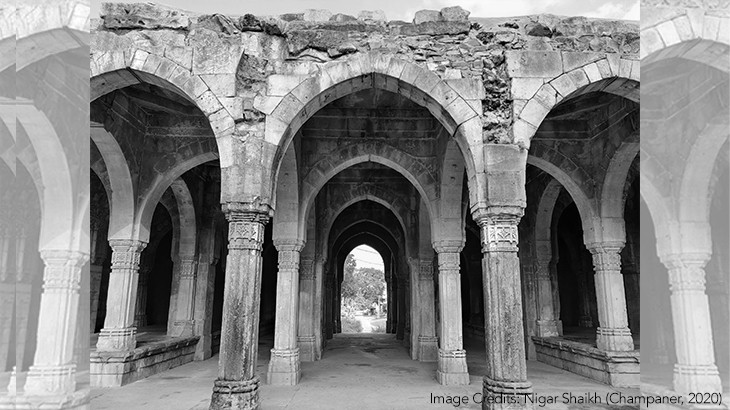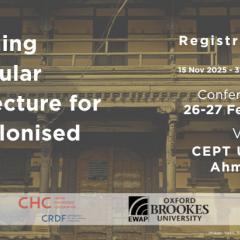
Structural Repairs and Maintenance for Built Heritage

Event
Sat, February 27, 2021 - Sat, March 20, 2021
10:30 am
Zoom Meeting
Course Brochure: Download here
Expression of interest: Online / Download the form
About the course
Whom it is for:
Primarily the course is targeted for civil engineers, professionals in the field of conservation of cultural heritage sites, teachers and researchers of Civil Engineering, Construction Technology, Architecture, Urban Design, and conservation will find this course extremely useful for understanding the structural conservation aspect for safeguarding the built heritage.
Course Structure
This course focuses on the approach to conserve the structural aspects of heritage buildings. It has been divided into four interdisciplinary modules. The first two modules will focus on understanding the structural system and construction materials of heritage structures. The methodology of determining the extent of damage and interventions required to curb those damages will be discussed during the third and the fourth module.
Modules:
Week 1: Basic Understanding of Structures
This module will deal with the basics of the heritage structures. The classification of heritage structures with respect to time, materials, and methodology of construction will be briefly discussed. Depending on the structural system of few monuments, the discussions will be elaborated on the types of loads coming on the structure, load flow path, joint mechanism of the Center for Heritage Conservation Page 2 of structural elements, and strengths and weaknesses of each will be highlighted. Common actions that induce stresses and strains in the structure, and any chemical, physical or biological phenomenon which affects the material, reducing its strength shall be discussed elaborately in this module. Learning Outcome: Participants will be able to recognize the structural behavior of some historic buildings, depending on the types and systems discussed in the module.
Week 2: Historic Building Materials
Most of our historic monuments and traditional buildings have been built using locally available materials, technology, and crafts skills. A scientific understanding of historic building materials and construction technology is a prerequisite for successful and sympathetic interventions on the built heritage. This module aims to introduce the participants to criteria and principles for the selection of appropriate building materials for repairs and restoration of historic structures. The key properties of traditional buildings materials; their common uses in construction; the processes of their deterioration and challenges in conservation and restoration will be discussed followed by an introduction to scientific techniques for investigation and material characterization leading to the selection of compatible materials for intervention. Widely used traditional materials - earth, timber, stones, and lime will be focused upon during this module. Learning outcome: Participants will be able to understand the key criteria and processes for the selection of compatible repair and restoration materials for built heritage conservation.
Week 3: Structural Assessment and Testing
This module will introduce the participants to the steps of structural assessment through input lectures and case study presentations. Prior to any structural strengthening or repair interventions in a heritage structure, the estimation of the expected strength of the existing structural elements is indispensable. This includes the evaluation of material strengths, extensive knowledge of the presence of cracks, joint openings, and other discontinuities. Investigation of the structure done in the right way can help in providing the most cost-effective optimal remedial solutions which would require the least amount of intervention. Impact of visual inspection, field and laboratory tests (destructive, non-destructive, and partially destructive) to determine mechanical, physical, and chemical characteristics and continuous monitoring methods will be discussed. Summarizing, this module emphasizes the various interventions and methodologies involved in the assessment (qualitative and quantitative approach of the damaged structures. The applicability of current standards and assessment of factors of safety will also be briefly discussed and will be supported by referring to the existing national and international case studies.
Week 4: Repair Techniques
To safeguard the cultural heritage, stabilization and strengthening of the structure are required. This module will focus on different repair techniques required for different types of material and damages in historic buildings. After the investigative procedure is completed, and the correct reason/s for the damage is diagnosed, the progressive phenomena of the assessed damages are studied and recorded. These observations lead to a suitable rational solution for structural repairs involving minimal interventions, cost-effectiveness, environmental sustainability, and feasibility of execution. The decisions regarding the interventions made should be taken after the careful diagnostic and safety evaluation by a team of individuals from various fields involved in conservation. These decisions should take into account both the structural safety and considerations of historic character. The various types of interventions, their pros, and cons based on the level of intervention, and their correlation with cost and historic character of the building will be discussed in this module.
In case you are unable to apply, please share the expression of interest with your CV at chc@cept.ac.in
Upcoming Events


Reframing Vernacular Architecture for a Decolonised World
February 26, 2026CEPT University, Ahmedabad, India